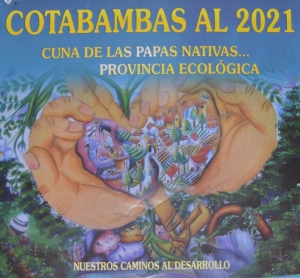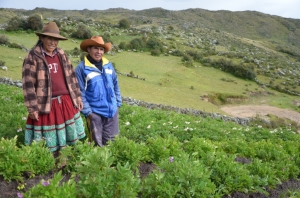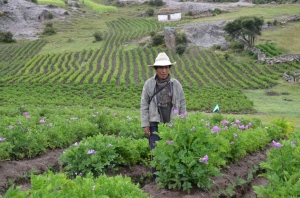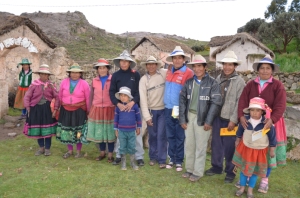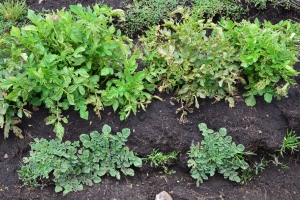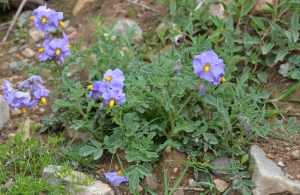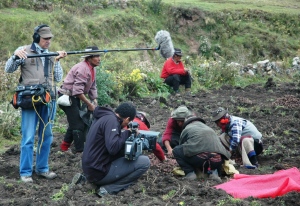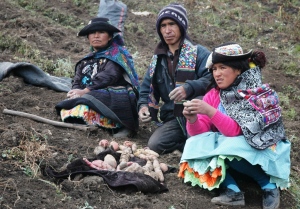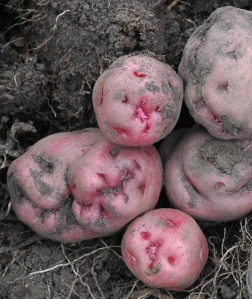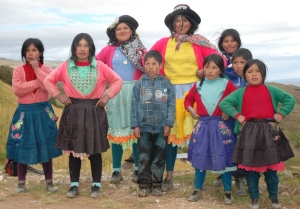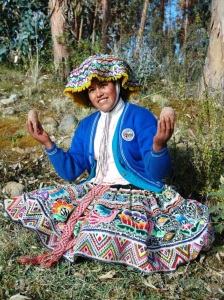Door Tabita Slimmens (student ontwikkelingsgeografie, Universiteit Utrecht), Carlos Arieht Molina Quispe (student anthropologie, Universiteit van Cusco) en Stef de Haan (Internationaal Aardappel Centrum, Lima)
Nog voordat de Spanjaarden Peru veroverden, waren er al vele gemeenschappen van boeren in het Andes gebergte die hoogtevloeren benutten om op een strategische manier de grond te benutten en voedsel te verbouwen. Na de verovering van Peru, en de oprichting van de Peruaanse natiestaat, is de strategie van de boeren in de bergen het grotendeels hetzelfde gebleven. Ze maken nog steeds op een creatieve en duurzame manier gebruik van alle beschikbare middelen in de gemeenschappen. De aardappel speelt een fundamentele rol voor een voedzaam dieet van de vele bewoners in de Peruaanse dorpen.
Lokale boeren experimenteren continu met verschillende technologieën en methoden om de landbouw te verbeteren, en de grond optimaal te gebruiken. Boeren wisselen kennis met elkaar uit, om zo een goede manier van cultiveren toe te passen. Ze maken bedachte keuzes, waarbij een continu proces van innovatie en evolutie van de inheemse aardappel centraal staan. In de gemeenschappen wordt veel traditionele kennis over het verbouwen van aardappelen gewaarborgd, waarbij vrouwen een centrale rol spelen. Zij behouden en vermeerderen een grote verscheidenheid aan landrassen, waarbij de kennis behouden en overgedragen wordt aan hun kinderen.
AGUAPAN (het Partnerschap van Bewakers van Aardappellandrassen in Centraal Peru), bestaat momenteel uit meer dan vijftig kleine telers uit bergdorpen, waarvan de leden erkend zijn als boeren ‘bewakers’ of guardians in het Engels. Ze telen een hoge diversiteit aan inheemse aardappelen, namelijk tussen de 50 en 500 landrassen en ze streven naar het behoud van zowel biodiversiteit als de cultuur rondom deze biodiversiteit. De leden vertegenwoordigen zichzelf, en hebben jaarlijks activiteiten om sociale netwerken te bevorderen en kennis uit te wisselen over het telen van aardappelen. Twee van de doelstellingen van AGUAPAN zijn het accepteren en opnemen van uitgesloten sociale groepen, en gender gelijkheid. Daarom laten wij in dit artikel twee vrouwen die lid zijn van AGUAPAN aan het woord.
De verhalen van Alda en Aurea
Alda Chavez Callupe is een boerin en guardian van de inheemse aardappel. Ze woont in het dorp Bellavista in de Pasco regio. Ze is momenteel 41 jaar oud en inmiddels gescheiden van haar man. Ze onderhoudt daarom zelf haar dochter, Yedali, van 14 jaar, en haar moeder, Faustina, van 68 jaar. Ze vertelde ons haar verhaal.

“Ik herinner mij uit mijn jeugd dat mijn moeder mij iedere ochtend wegstuurde, voordat ik naar school ging. Deze plaats heette Mollyay, en het was heel ver weg. Ik moest daar iedere ochtend de varkens voeren, en daarna rende ik snel naar huis om naar school te gaan.”
Na haar eerste jaar op de middelbare school, had haar gezin haar nodig. Ze wijdde haar leven sindsdien aan de landbouw.
“Mijn broer woonde met zijn gezin in een ander huis, maar toen ik 13 was stierf hij. Er was daardoor niet langer iemand die mijn vader en de produktie kon ondersteunen. Daarom verliet ik school, om ons gezin te onderhouden.”
Aurea Eulalia Mendoza Capcha, een andere guardian van de inheemse aardappel, woonachtig in het dorp La Quinua in de Pasco regio, verteld over haar vele herinneringen van het leven in de hooglanden. Ze woont nu bij haar ouders met haar broer en zijn dochter van één. Samen met haar moeder is ze verantwoordelijk voor het onderhoud van het gezin. En ze verteld met nostalgie in haar stem over haar jeugd:

“Als kind ging ik altijd met mijn ouders mee naar de velden. We telen alles samen, en we werken dus ook allemaal op het land. Vroeger was het anders. Mensen sliepen bij hun stuk land, en kwamen voor lange tijd niet thuis. Mijn moeder nam zelfs haar kippen mee. We moesten toen altijd van school naar het veld en andersom. We begonnen in de ochtend met werken, en moesten daarna naar school van 13.00 tot 17.30. Dan moesten we na school naar het veld om daar te slapen. We wandelden dan in het donker. Nu is het vaak zo dat mensen terugkeren naar hun huis na werk. Het is niet meer zoals vroeger.”
Alda heeft van haar vader geleerd over het beheer en behoud van de aardappel diversiteit. Ze hebben samen verschillende prijzen gewonnen voor het telen en kennis van de verschillende landrassen. Dit motiveerde ze om nog meer inheemse rassen te verzamelen.
“Ik heb de passie, om aardappelen te verzamelen, van mijn vader gekregen. Toen ik een klein meisje was nam hij al deel aan pootgoed markten. Toen hij oud werd, en het zelf niet meer kon, nam ik zijn werk over. Toen mijn vader deel nam aan de markten wonnen we regelmatig. We kregen een grote oven, een koelkast en verschillende kruiwagens.”
De prijzen en de kennis waar Alda over beschikt, riep bewondering op bij de rest van de gemeenschap. Er wordt haar verteld dat zij in het gebied van Paucartambo, waar ze woont, de grootste hoeveelheid van aardappelsoorten en lanrassen heeft. Naast bewondering van de rest van het dorp, heeft haar werk haar in staat gesteld om deel te nemen aan verschillende projecten en organisaties, waaronder AGUAPAN. Op die manier heeft ze kunnen profiteren van kennis van anderen, en haar diversiteit van de inheemse aardappel kunnen vergroten.
“Door het reizen naar verschillende plaatsen om bijeenkomosten en markten te kunnen bijwonen, krijg ik een grote diversiteit van aardappel landrassen uit verschillende regio’s te zien. Deze rassedn heb ik vaak nog niet, dus dan ruil of koop ik ze. Vanuit AGUAPAN krijgen alle leden steun om diverse inheemse rassen te blijven telen. We krijgen lezingen, trainingen en houden bijeenkomsten vanuit verschillende regio’s in Peru. Vaak hebben ze in andere regio’s andere manieren om aardappelen te telen. Pasco is anders dan bijvoorbeeld Huancavelica of Junín. Wanneer we samen zijn, leren we van elkaar. Boeren uit Huancavelica vertelde bijvoorbeeld dat ze hun gewassen op natuurlijke wijze beheren, zonder chemicaliën. Ik denk dat ik dit volgend jaar ook moet doen om te zien of het goed uitpakt.”
Eén van de belangrijkste redenen waarom boeren in de Andes de oude inheemse aardappels blijven telen is de smaak. Boeren en anderen die de aardappelen proberen zijn het eens over de uitzonderlijke smaak en textuur. Aurea vertelt dat de aardappel een van de meest belangrijke producten is voor het dieet van de boeren in de Andes.
“Het is een gewoonte, een traditie en een enorm voedzaam product. Zonder aardappel hebben wij geen goed eten, we eten het namelijk elke dag.”
Alda voegt hieraan toe dat de voorkeur van smaak van inheemse aardappelen van generatie op generatie wordt overgedragen.
“Ik herinner me een aardappel in het bijzonder. We noemden het een koekje, omdat hij zo lekker was. Het is een geelachtige aardappel van binnen maar van buiten is hij zwart. In Quechua noemen we hem Yana Huayro. Ik lustte als meisje geen inheemse aardappels, behalve deze. Ik probeerde altijd alleen deze te eten. Ik zie nu hetzelfde bij mijn neefjes en dochter. Ze kijken of ze de aardappel vinden die aan de buitenkant zwart is en aan de binnenkant geel.”
Kennis van inheemse aardappelen en landrassen kan op verschillende manieren voor profijt zorgen van boeren. Naast dat er prijzen gewonnen kunnen worden op pootgoed markten, profiteren boeren ook door betere leefomstandigheden. Een kans die vooral voor vrouwen erg bijzonder is, is dat ze de mogelijkheid krijgen om te reizen. Normaal gesproken krijgen ze niet de mogelijkheid om verschillende plaatsen te bezoeken omdat ze traditioneel gezien het huis en de dieren verzorgen. Mannen daarentegen krijgen oorspronkelijk meer kans om te reizen. Alda verteld ons over haar ervaring met reizen, en hoe de traditionale kennis over de inheemse aardappel haar deze kans gaf.
“Ik heb een voordeel dankzij mijn aardappelen. Ik ben in Ecuador geweest voor een bijeenkomst met aardappelproducten. Ik was daarvoor nog nooit in het buitenland geweest dus dit was erg bijzonder. Vroeger had ik nooit nagedacht over de optie om bijvoorbeeld naar Cuzco te gaan, totdat mijn klasgenoten een keer naar Cuzco waren gelopen. Afgelopen jaar had ik besloten om ook te gaan. Ik ken nu meer plekken, ook dankzij AGUAPAN omdat we met de groep één keer per jaar reizen en samen komen. Mijn moeder zegt dat ik om die reden God dankbaar moet zijn, omdat ik profiteer van de aardappelen die we hebben.”
Alda is enthousiast over AGUAPAN. Ze vertelde ons het volgende:
“AGUAPAN stimuleert en geeft on motivatie om door te gaan met de teelt van de honderden landrassen. Ze geven ons bijvoorbeeld hulp om arbeiders voor op het land te vinden, of om onze gezondheid te verbeteren, of de studie van mijn dochter te betalen. Ik ben ze dankbaar voor de erkenning. Ze waarderen ons werk en ik vraag me soms af waarom niet meer mensen ons werk waarderen. Ik zou willen dat heel Peru ons steunt, en dat ze onze inheemse aardappelen waarderen waardoor wij vooruitgang kunnen boeken.”
Hoewel de boeren in Peru dus creatief zijn met het gebruik van de beschikbare middelen, zijn er regelmatig nog tekorten, of zorgen over de kwaliteit van leven. Dit geldt niet alleen voor Alda, maar voor meer boeren in de hooglanden met een vergelijkbaar leven.
“Elke dag vraag ik me af of mijn dochter kan gaan studeren. Ze is 14 en wilt het liefst meerdere banen later. Naast dokter wil ze ook politieagent worden. Maar hoe kan ik ervoor zorgen dat ze dat kan?” Het leven als boer in de Andes is zeker nog niet volmaakt. Het belang van gelijkwaardige participatie van vrouwen en mannen in AGUAPAN is dan ook erg groot. Ze geven de boeren guardians erkenning, een stem en steun, waarbij deze de kans krijgen hun krachten te bundelen om hun eigen leven en dat van hen kinderen te verbeteren. Ze verdienen begrip en erkenning voor dit werk vanuit een breder publiek. Op die manier kan de traditie, het gebruik en de evolutie van de aardappel in hun oorsprongsgebied in stand gehouden worden.


